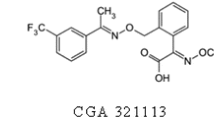Abstract
The present study was done to assess the dissipation behavior, decontamination, and half-life time of ready-mix formulation of trifloxystrobin (25% w/w) and tebuconazole (50% w/w) in okra and soil under the crop after foliar spray at fruiting stage. Samples of okra and soil were collected periodically, i.e., zero (2 h after spray), 1, 3, 5, 7, 10, 15, 20, and 25 days after third application at a 7-day interval. Residues of these fungicides were determined by gas liquid chromatography (GLC) equipped with electron capture detector (ECD) and gas chromatography-tandem mass spectrometry (GCMS-triple quadruple). The limits of quantification (LOQ) and detection (LOD) for both the fungicides were 0.01 and 0.003 mg kg-1, respectively. Washing alone with faucet water was found successful in minimizing the residues. Soil was free from residual contamination at fifth day after spraying in case of both the fungicides and at both the doses.


Similar content being viewed by others
References
Anonymous, (2016). https://www.healthline.com/health/diabetes/okra2016.
Anonymous, (2017). Horticultural statistics at a glance. www.agricoop.nic.in.
Anonymous, (2018). https://www.curejoy.com/content/health-benefits-of-okra/2018.
Dhanker, P. (2017). Persistence study of tebuconazole in chilli and soil. M.Sc. Thesis, Chaudhary Charan Singh Haryana Agricultural University, Hisar.
Gupta, S. P., Singh, S. P., Satyanarayana, P., & Kumar, N. (2015). Dissipation and decontamination of imidacloprid and lambda-cyhalothrin residues in brinjal. International Journal of Plant Protection, 8(2), 379–383.
Kang, B. K., Jyot, G., Sharma, R. K., Battu, R. S., & Singh, B. (2010). Persistence of propargite on okra under subtropical conditions at Ludhiana, Punjab. Bulletin of Environmental Contamination and Toxicology, 85, 414–418.
Kaur, S., Takkar, R., Bhardwaj, U., Kumar, R., Battu, R. S., & Singh, B. (2012). Dissipation kinetics of trifloxystrobin and tebuconazole on wheat leaves and their harvest time residues in wheat grains and soil. Bulletin of Environmental Contamination and Toxicology, 89(3), 606–610.
Kumari, B., Madan, V. K., & Kathpal, T. S. (2008). Status of insecticide contamination of soil and water in Haryana, India. Environmental Monitoring and Assessment, 136, 239–244.
Litoriya, N. S., Joshi, M. N., Singh, S., Patel, A. R., & Shah, P. G. (2017). Persistence and residues of a combi product of trifloxystrobin and tebuconazole on banana. Pesticide Research Journal, 29(1), 35–41.
Mandal, S. K., Sah, S. B., & Gupta, S. C. (2006). Screening of okra cultivars against Earias vitella. Annals of Plant Protection Science, 14, 462–524.
Mohapatra, S. (2015). Residue levels and dissipation behaviors for trifloxystrobin and tebuconazole in mango fruit and soil. Environmental Monitoring and Assessment, 187, 95. https://doi.org/10.1007/s10661-015-4324-x.
Nitesh, S., Litoriya, S. H., Patel, M., Joshi, N., Kaushik, D. P., Chawla, S., & Shah, P. G. (2017). Dissipation kinetics, residue status and risk assessment of trifloxystrobin and tebuconazole combi-product in cowpea. Pesticide Research Journal, 29(2), 196–203.
Sahoo, S., Jyot, G., Battu, R., & Singh, B. (2012). Dissipation kinetics of trifloxystrobin and tebuconazole on chili and soil. Bulletin of Environmental Contamination and Toxicology, 88, 368–371.
Walter, J. K., Arsenault, T. L., Pylypiw, H. M., & Mattina, M. J. I. (2000). Reduction of pesticide residues on produce by rinsing. Journal of Agriculture Food Chemistry, 48, 4666–4670.
Wang, Y., Wang, C., Gao, J., Chang, L., Cui, L., & Li, A. (2015). Dissipation, residues, and safety evaluation of trifloxystrobin and tebuconazole on ginseng and soil. Environmental Monitoring and Assessment, 187, 344. https://doi.org/10.1007/s10661-015-4591-6.
Acknowledgments
The authors are thankful to CCS Haryana Agricultural University, Hisar, and the Indian Council of Agricultural Research (ICAR), New Delhi, for providing necessary facilities during the study.
Author information
Authors and Affiliations
Corresponding author
Additional information
Publisher’s note
Springer Nature remains neutral with regard to jurisdictional claims in published maps and institutional affiliations.
Rights and permissions
About this article
Cite this article
Ahlawat, S., Chauhan, R., Rani, S. et al. Dissipation and decontamination behavior of pre-mix formulation of tebuconazole and rifloxystrobin fungicides in okra. Environ Monit Assess 191, 628 (2019). https://doi.org/10.1007/s10661-019-7790-8
Received:
Accepted:
Published:
DOI: https://doi.org/10.1007/s10661-019-7790-8




